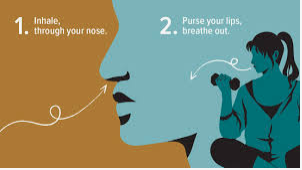What is breathing trouble?

Breathing trouble describes discomfort when breathing and feeling as though you can’t get an entire breath. The medical term for shortness of breath is ‘dyspnea.’ It can come on suddenly or over weeks to months. It may occur when walking, climbing stairs, running or sitting still.
Symptoms of shortness of breath
Symptoms of shortness of breath can include:
- Feeling like you have to work hard to breathe
- Pain, discomfort or tightness in the chest
- Fast breathing, heartbeat or both
- Wheezing
- Cough
- Feeling panicked or anxious
- Feeling lightheaded or even passing out
- Swelling (edema) of your feet and ankles
- Feeling breathless in the sitting or standing position and better when lying flat
- Fingers/feet/lips turning blue (called cyanosis)
What causes shortness of breath?
Heart and lung conditions are common causes of shortness of breath. Your heart and lungs move oxygen throughout your body and remove carbon dioxide. Breathing is regulated by the brain. It is an interaction between chemicals in the blood and in the air that we breathe.
People who have advanced liver disease can have complications that affect the heart and lungs. Breathing problems can occur because you can’t take as big a breath due to:
- A build-up of fluid in the belly (ascites). This buildup of fluid can compress the lungs and make it difficult to breath or take in deep breaths. The best way to improve your breathing is to get rid of the fluid (paracentesis) and take all medications prescribed by your doctor to manage ascites.
- A build-up of fluid between the tissues that line the lung and chest (pleural effusion)
- A large spleen and liver that pushes the diaphragm up.

Things you can try to prevent and control shortness of breath:
- Pace yourself
- Trying not to hold your breath
- Sit in front of a fan so it blows on your face
- Sit upright. Using pillows to support your back may help
- Maintain humidity in your room
- Sit near an open window
- Try meditation, mindfulness, or relaxation therapy
What are some relaxation techniques?
Some of your healthcare providers may be able to teach you relaxation techniques or you can learn some on your own. Some techniques include:
- Progressive muscle relaxation (focus on slowly tensing and then relaxing each muscle group)
- Visualization (form mental images to take a visual journey to a peaceful, calming place or situation)
- Music and art therapy
Breathing problems and liver disease
Breathing problems can also occur with liver disease from changes in the blood vessels and blood flow in the lungs.
One problem that can develop with liver disease is portal hypertension. Portal hypertension refers to increased pressure in the blood vessel that enters the liver.
Liver disease and portal hypertension can cause problems in the blood vessels of the lungs. One factor that causes problems in the blood vessels of the lungs is the damaged liver’s inability to remove harmful substances from your digestive tract before they enter the rest of your body. These toxins can damage blood vessels in your lungs leading to larger or more narrow vessels. Two different conditions can be seen in the lungs that arise from liver disease:
Hepatopulmonary syndrome
Hepatopulmonary syndrome is a condition where the blood vessels in your lungs become enlarged, leading to low oxygen levels. Symptoms of hepatopulmonary syndrome are mostly caused by low oxygen levels in the blood. You may find yourself experiencing the following signs or symptoms:
■ Becoming short of breath easily
■ Feeling breathless in the sitting or standing position
■ Fingers/feet/lips turning blue (called cyanosis)
Diagnosis
There are three basic features required to make a diagnosis of hepatopulmonary syndrome:
■ low blood oxygen levels
■ enlarged blood vessels in the lungs
■ liver disease
You must have all three features to be diagnosed with hepatopulmonary syndrome. Your healthcare provider will usually order a sample of blood from an artery (arterial blood gas) test to evaluate your blood oxygen levels. Your healthcare provider may also order tests to look for enlarged blood vessels in your lungs.
Treatment
The only definitive treatment for hepatopulmonary syndrome is liver transplant. When liver transplant is not an option, there are limited medical therapies available.
Portopulmonary hypertension
Portopulmonary hypertension is a condition where the blood vessels in your lungs become narrowed, leading to increased blood pressure in the vessels of the lungs which obstructs the flow of blood through the lungs.
Symptoms
You may find yourself experiencing the following signs or symptoms:
■ Becoming short of breath or tired easily
■ Chest pain, which can be mistaken for a heart attack
■ Feel your heart pounding or racing
■ Feel lightheaded or even pass out
■ Swelling (edema) of your feet and ankles.
Diagnosis
The diagnosis of portopulmonary hypertension is made when you have increased lung (pulmonary) pressure and liver disease.
Treatment
Treatment of portopulmonary hypertension depends on the condition of your liver. Therapies can include:
- medical therapy to widen the pulmonary blood vessels
- liver transplant
